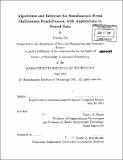Algorithms and inference for simultaneous-event multivariate point-process, with applications to neural data
Author(s)
Ba, Demba Elimane
DownloadFull printable version (9.607Mb)
Other Contributors
Massachusetts Institute of Technology. Dept. of Electrical Engineering and Computer Science.
Advisor
Emery N. Brown.
Terms of use
Metadata
Show full item recordAbstract
The formulation of multivariate point-process (MPP) models based on the Jacod likelihood does not allow for simultaneous occurrence of events at an arbitrarily small time resolution. In this thesis, we introduce two versatile representations of a simultaneous event multivariate point-process (SEMPP) model to correct this important limitation. The first one maps an SEMPP into a higher-dimensional multivariate point-process with no simultaneities, and is accordingly termed the disjoint representation. The second one is a marked point-process representation of an SEMPP, which leads to new thinning and time-rescaling algorithms for simulating an SEMPP stochastic process. Starting from the likelihood of a discrete-time form of the disjoint representation, we present derivations of the continuous likelihoods of the disjoint and MkPP representations of SEMPPs. For static inference, we propose a parametrization of the likelihood of the disjoint representation in discrete-time which gives a multinomial generalized linear model (mGLM) algorithm for model fitting. For dynamic inference, we derive generalizations of point-process adaptive filters. The MPP time-rescaling theorem can be used to assess model goodness-of-fit. We illustrate the features of our SEMPP model by simulating SEMPP data and by analyzing neural spiking activity from pairs of simultaneously-recorded rat thalamic neurons stimulated by periodic whisker deflections. The SEMPP model demonstrates a strong effect of whisker motion on simultaneous spiking activity at the one millisecond time scale. Together, the MkPP representation of the SEMPP model, the mGLM and the MPP time-rescaling theorem offer a theoretically sound, practical tool for measuring joint spiking propensity in a neuronal ensemble.
Description
Thesis (Ph. D.)--Massachusetts Institute of Technology, Dept. of Electrical Engineering and Computer Science, 2011. Cataloged from PDF version of thesis. Includes bibliographical references (p. 115-118).
Date issued
2011Department
Massachusetts Institute of Technology. Department of Electrical Engineering and Computer SciencePublisher
Massachusetts Institute of Technology
Keywords
Electrical Engineering and Computer Science.